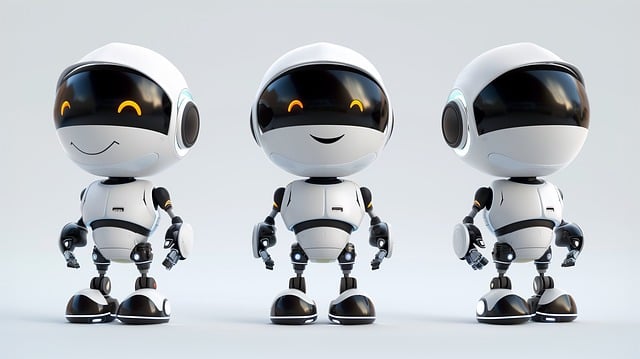Chatbot AI, powered by Natural Language Processing (NLP) and Machine Learning (ML), revolutionizes interactions with contextually relevant responses and continuous learning. Designed for conversation, these bots engage users through structured dialogues, anticipation of queries, and personalized scripts. Development involves selecting the right tools, from low-code platforms to advanced SDKs, based on complexity and integration needs. Training and fine-tuning, using diverse datasets and iterative adjustments, enhance chatbot intelligence. Deployment integrates chatbots into communication channels, while ongoing feedback and performance monitoring ensure dynamic refinement in a rapidly evolving digital world. Key focus areas include conversation design, NLP understanding, and regular updates for optimal chatbot AI experiences.
Building a chatbot has become an accessible, powerful way to enhance customer service and engagement. This comprehensive guide takes you on a journey through the entire process of creating your own AI-powered conversational agent. From understanding the fundamentals of chatbot AI and its various types, to designing engaging dialogue, choosing development tools, training models, and continuous improvement through deployment and iteration, we demystify each step. By the end, you’ll be equipped with the knowledge to create intelligent, responsive chatbots.
- Understanding Chatbot AI: Defining and Demystifying the Technology
- Designing for Conversation: Crafting Engaging and Effective Dialogue
- Choosing the Right Tools and Platforms for Development
- Training and Fining-Tuning: Making Your Chatbot Intelligent and Responsive
- Deployment and Iteration: Bringing Your Chatbot to Life and Ensuring Continuous Improvement
Understanding Chatbot AI: Defining and Demystifying the Technology

Chatbots have become an integral part of our digital interactions, offering instant assistance and information access. At their core, these virtual assistants are powered by Chatbot AI (Artificial Intelligence). Understanding chatbot AI involves grasping its fundamental technology and capabilities. In essence, Chatbot AI is a computer program designed to simulate human conversation through natural language processing (NLP) and machine learning (ML) techniques. These technologies enable chatbots to interpret user queries, generate contextually relevant responses, and learn from these interactions over time.
By demystifying chatbot AI, we realize that it’s not just about responding to simple questions but involves complex processes. NLP allows chatbots to understand human language nuances, while ML ensures they can adapt and improve based on user input. This dynamic interplay fosters more engaging and personalized conversations, making Chatbot AI a versatile tool for various applications, from customer service and education to healthcare and entertainment.
Designing for Conversation: Crafting Engaging and Effective Dialogue

Designing for conversation is a crucial aspect of building an effective chatbot AI. It involves creating dialogue that feels natural and engaging, mimicking human interactions as closely as possible. To achieve this, developers must consider the flow of conversations, anticipating user queries and crafting relevant responses. Incorporating branching narratives and conditional logic allows the chatbot to adapt its replies based on user input, enhancing the overall experience.
Engaging and effective dialogue also relies on understanding user intent. By utilizing natural language processing (NLP) techniques, chatbots can interpret user requests, ensuring they provide accurate and contextually appropriate answers. Regularly updating and refining conversation scripts is essential to keep up with evolving user needs and preferences, making interactions more dynamic and satisfying.
Choosing the Right Tools and Platforms for Development

When building a chatbot, selecting the appropriate tools and platforms is a pivotal step in the development process. The right choice can significantly impact your chatbot’s performance, scalability, and ease of maintenance. Key considerations include the complexity of your chatbot ai, desired integration capabilities, and your team’s technical expertise.
Popular options range from low-code/no-code platforms ideal for simple bots to robust SDK (Software Development Kits) and frameworks that offer advanced customization for sophisticated chatbot AI. Platforms like Dialogflow, IBM Watson, Microsoft Bot Framework, and Rasa provide a wide array of features, including natural language processing, intent recognition, and machine learning capabilities. Evaluating your project’s unique needs and aligning them with the platform’s strengths will ensure a successful chatbot development journey.
Training and Fining-Tuning: Making Your Chatbot Intelligent and Responsive

Training and fine-tuning are pivotal steps in developing a chatbot AI that provides accurate and contextually relevant responses. Initially, chatbots are trained using vast datasets containing human conversations to learn patterns, grammar, and semantic meanings. This process enables the chatbot to understand user inputs and generate appropriate outputs. However, off-the-shelf training doesn’t make for perfect performance. That’s where fine-tuning comes in—a meticulous process involving adjustments to the chatbot’s algorithms and parameters based on its interactions with users.
Fine-tuning involves exposing the chatbot to a more diverse set of user queries, including edge cases and specific domains relevant to its intended use. By iteratively analyzing responses for inaccuracies or shortcomings and making corresponding adjustments, developers can significantly enhance the chatbot’s intelligence and responsiveness. This iterative approach ensures that the AI chatbot not only learns from its interactions but also adapts and improves over time.
Deployment and Iteration: Bringing Your Chatbot to Life and Ensuring Continuous Improvement

Once your chatbot is built, it’s time to bring it to life through deployment. This involves integrating the AI-powered chatbot into existing communication channels like websites, messaging apps, or social media platforms. A seamless deployment ensures users can access and interact with your chatbot effortlessly. As you launch, gather user feedback and monitor performance metrics such as response accuracy, user satisfaction, and engagement rates.
Iterative improvement is key to refining your chatbot AI. Regularly update the conversation flow based on user interactions and feedback. Enhance its capabilities by expanding the knowledge base, improving natural language understanding, and personalizing responses. Continuous iteration not only improves user experience but also keeps your chatbot relevant and engaging in a dynamic digital landscape.
Building a chatbot isn’t just about creating a talking bot; it’s about crafting an intelligent, engaging conversational AI that enhances user experiences. By understanding the fundamentals of chatbot AI, designing intuitive dialogues, choosing the right tools, and continuously refining its performance through training and deployment, you can create a chatbot that delivers valuable interactions and becomes an integral part of your digital ecosystem. Embrace the power of chatbot ai to foster meaningful connections with users and revolutionize customer engagement.
